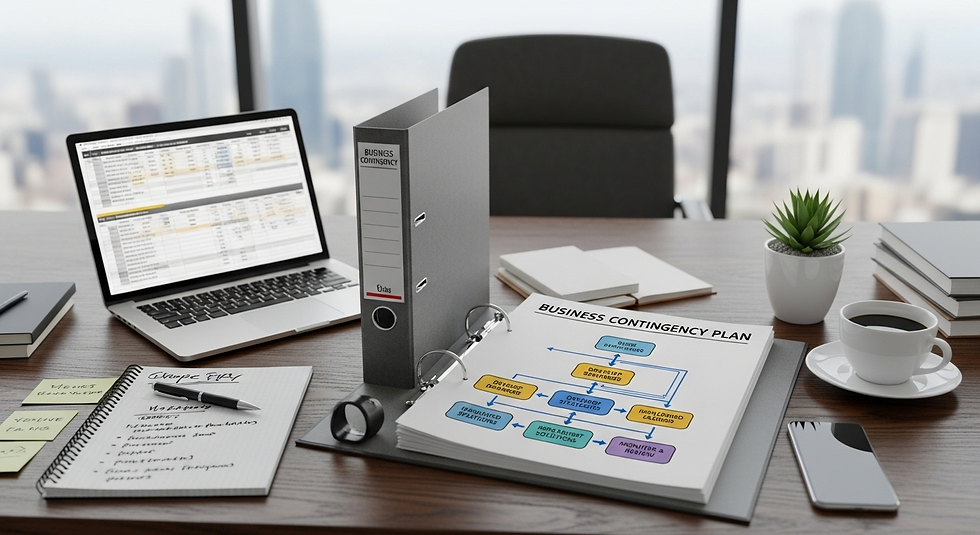10 Proven Strategies to Build a Resilient Business Continuity Plan
- rebekahh84
- Jul 17
- 5 min read

Can your company afford not to be prepared? Should you allow your destiny to be based and put in the hands of others?
Disruptions can strike without warning in any business. Successful businesses often face a wide range of threats that might disrupt their operations. It is where business continuity strategy helps them to maintain normal business operations in any sort of disaster.
A resilient business continuity plan ensures that the business can respond quickly and recover with minimal disruptions.
What is business continuity?
Business continuity is the ability of an organization to maintain critical business functions in the event of a crisis. These crises can occur from
Cyberattacks
Fires
Supply chain failures
Strong business continuity includes the implementation of disaster recovery strategies that help prevent long shutdowns and dangerous breaches. Having a successful business continuity strategy helps an organization to recover quickly when disaster threatens its core operations.
10 Key Strategies to Build a Resilient Business Continuity Plan
This guide explores 10 proven strategies for building a business continuity plan that prepares your company for the unexpected. These practical steps will help improve your resilience and stability in any situation.
1. Build Your Plan Around Core Business Functions
You should not build your plan for each possible scenario. It is better to create a plan that focuses on the most important business functions. This will work no matter what type of disruption takes place.

For example, your plan should help your team recover customer service or data access or facility use or staff availability. It should not depend on the reason for the crisis. You should focus on the function that is affected and not the specific cause such as a flood or a cyber attack.
2. Rethink Team Structures and Assignments
Your team plays an important role in recovery. It is better to build teams that understand business functions clearly. This means each department should have members who know how to bring that function back to normal.
For example, the finance team may need one person to manage payments and another to manage reports. You must give each person a clear role and specific task. This makes recovery faster and easier because there will be no confusion.
3. Include Critical Third-Party Providers in Your Strategy
Most companies depend on third party services that provide IT support or cloud systems or payment processing or data security. You should include these providers in your continuity planning because their support is essential.
Rate each vendor based on how important they are. A low rating means the vendor is easy to replace. Whereas, a high rating means the vendor is critical and cannot be replaced during a crisis.
Make sure you have the correct contact details for all major vendors. You should also let them know how they are expected to support your recovery. Their response time and their recovery plan should be clearly written in your service agreements.
4. Simplify Your Recovery Team for Efficiency
One of the most important factor that can affect the success of your business continuity plan is how quickly your business can respond. Any kind of emergency must be addressed without hesitation because of the limitation of time. When there are too many people involved in the process it becomes difficult to act fast. This can lead to delays which may cause confusion and slow down recovery efforts.
That is why you must select a team for the recovery. Once you choose the right team members you must also ensure they receive proper training. This training should cover their responsibilities and the tools they will use during recovery. It should also include practice sessions or simulations that prepare them for real-life scenarios.
Also Read: What is the primary goal of business continuity planning?
5. Make Documentation Clear and Easy to Understand
A business continuity plan must be easy to use. Each section of the plan must have a clear layout. You should include steps for each task and list all roles and functions. This will help your team know what to do when a disruption takes place.
If someone finds the instructions difficult to understand then it means the document needs improvement. A simple and well-written plan saves time and prevents mistakes.

6. Standardize Internal Communication Channels
Most teams use different ways to communicate, such as
Email
Phone
Chat
Video calls
This can create problems during a crisis because messages may not reach everyone at the same time.
You should use one system to send all important updates. A standard messaging tool will make sure that everyone gets the same message quickly. It will also make tracking and decision-making easier.
7. Secure and Allocate Resources Wisely
Your recovery plan must also cover the resources that your team needs. This includes tools such as computers and internet connections and secure access to systems.
You should decide in advance if your staff will work from home or from another office. Then you must make sure the location has the right equipment. You should also make sure staff are familiar with the setup before an emergency takes place.
Do not forget to include other supplies such as drinking water and food and medicine. You should check your supply list often to make sure everything is available and in good condition.
8. Identify and Prepare Alternative Locations

If your main office is not available then your team must have access to another location. You should prepare backup offices that can support important functions such as customer service and data recovery.
This is very useful for companies that have more than one branch. You should choose locations that help your team continue work at a basic level until full operations are restored.
9. Automate Access to Your Continuity Plan
During a crisis your team may be working from different places. This means your continuity plan must be stored in a secure online system. Everyone should be able to access the plan anytime and from anywhere.
You should store your instructions and contact lists in one central system.
This helps your team follow the right steps without delay. You might take help from automation also reduces mistakes and supports faster decisions.
10. Understand Departmental Interdependencies
Each department needs help from others to do its job well. For example, customer service may depend on the IT team and the finance team to support certain tasks.
You should map these connections between departments in your plan. This will help each team understand what other teams need from them. It will also make sure that all parts of the company recover in the right order.
Final Thoughts
A strong business continuity plan helps your business stay open when things go wrong. You should focus on the most important business functions and you should train your teams to respond quickly. You should also make sure your systems and supplies are ready before a crisis happens.
If you want expert help then you can work with a trusted business continuity consultant. These professionals can help you build and test a plan that fits your exact needs. They also offer advice on how to manage vendors and recover faster.
You can learn more from experienced advisors at Business Contingency Group. We offer services in disaster recovery consulting and continuity planning.




Comments